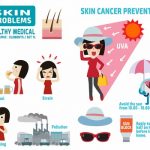May is Skin Cancer Detection and Prevention Month. Skin Cancer is one of the most common types of cancer. One of the main causes of skin cancer is the ultraviolet (UV) radiation from the sun, tanning booths, and sun lamps.
One of the most dangerous types of cancer is melanoma. When this is detected early, there is usually a cure.
How Skin Cancer Detection and Prevention can make a difference
It is important to use this month to raise awareness about skin cancer. Let’s help take action to prevent or detect it – both at home and in the community. Some things we can do to help prevent this is:
- Wear sunscreen.
- Limit your time in the sun.
- Teach others about the harm of UV radiation.
- Do not burn.
- Tan gradually.
- Wear protective clothing.
- Take Vitamin D.
- Seek Shade.
If you have practiced sun safety all summer, you still need to be vigilant about your skin in the fall, winter, and spring months. During the course of the year, it is important to examine your skin head to toe once a month and look for any suspicious lesions. Self examinations can help identify anything worrisome early on. In a self-examination, you should look for any new moles or growths. Obviously, if you see any significant changes, you itch, or bleed, these are signs you shouldn’t ignore.
Melanoma
Melanoma is the deadliest form of skin cancer. Anyone who has more than 100 moles is at greater risk for melanoma. The first signs can appear in one of the more atypical moles. It is important to know your body and skin and recognize any changes in the moles on your body.
ABCDE’s of Melanoma
Asymmetry – If you draw a line through a mole and the two halves don’t match, it means it is asymmetrical. This is a warning sign. Borders – The borders of a mole tend to be uneven, or raised. Color – If you see a lot of colors in a mole, this is a sign of melanoma. Diameter – usually benign moles are small. A mole larger than a pencil tip is a serious sign. Evolving – when a mole begins to itch, change, bleed, or grow, this is considered a warning sign. Do not ignore any of the ABCDE’s of Melanoma. Moreover, make an appointment with a Physician immediately if you notice any changes in your skin or body.
Let’s eradicate skin cancer and melanoma by being more diligent in taking care of our skin and body. In any event, early skin cancer detection is important.
In conclusion, Skin Cancer Detection and Prevention Month is a month to practice skin safety.







